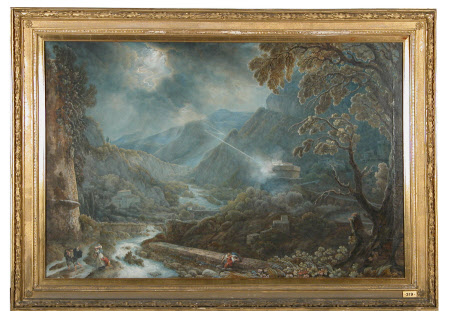The Valley of the Nera
Abraham-Louis-Rodolphe Ducros (1748 - 1810)
Category
Art / Drawings and watercolours
Date
1748 - 1810
Materials
Watercolour and bodycolour (partly varnished) on paper
Measurements
781 x 1181 mm (30 3/4 x 46 1/2 in)
Place of origin
Umbria
Order this imageCollection
Stourhead, Wiltshire
NT 730805
Summary
Watercolour and bodycolour (partly varnished), on paper, The Valley of Nera by Abraham Louis Ducros (Yverdon, Switzerland 1748 – Lausanne 1810). The valley, surrounded by mountains, is seen during a storm; a castle is struck by lightning.
Full description
E. K. Waterhouse once observed that the Ducros drawings at Stourhead are the only known group by this artist in England. Indeed, Richard Colt Hoare had a profound admiration for his work (see his comments in Modern Wiltshire, 1822), and that he was on friendly terms with the artist is indicated by the inscription on the back of NT 730807 in this series: ‘pour Monsieur Hoare’. Also a letter of Ducros to Colt Hoare is preserved among the Stourhead archives, from Malta on 22 August 1800, he proposes opening a subscription for a series of views of that country, where, he comments: 'Je retrouve Claude Laurin et Vernet a chaque instant'. No views of Malta are at Stourhead, and the eleven drawings listed by Colt Hoare are of Rome, Tivoli and the countryside as far north as Lake Trasimene. For a brief account of Ducros, a Swiss who worked in Italy, mainly in Rome, from around 1770-1805 (see Bell Walpole Society XXIII, 1935 & see D. Agassiz, A.L.Ducros, 1927). In an appendix Agassiz lists paintings and drawings by Ducros in the Musée des Beaux-Arts, Lausanne, which include preliminary sketches for Stourhead watercolours. Among them is a title which suggests similarity to a drawing at Coughton (NT), in some way confirming that the Neapolitan scenes at Coughton are indeed by Ducros (the artist settled in Naples around 1793 after his expulsion, together with other French residents following the death of Louis XVI, from Rome). Agassiz quotes a letter from P-L de la Rive to Mme de la Rive, Rome 16th February 1785 (p.11): 'Son talent pour la peinture est bien reel mais il se fait aider prodigieusement par des peintres d'histoire pour ses figures et par des architectes pour ses monuments'. Colt Hoare distinguished four drawings, probably of around 1786: Trasimene (NT 730815), Tivoli (NT 730810), the Tomb of the Plautii (NT 730817) and Civita Castellana (NT 730807), which were the earliest (on 21 February 1787 Colt Hoare wrote to Hugh Hoare to say that 'last year' Ducros had done these four drawings, which had been sent to England) to enter his collection and among which he notices a progressive strength from the first to the last. Whether or not this is apparent, a comparison with the remainder of the drawings suggests that these four are less dramatic and colourful and would therefore appear to be earlier. 'A dignity of design and depth of tone' is how Bell describes the artist's mature works. It is not clear whether Colt Hoare, in his list of the other seven drawings, is intending to present a chronological sequence as he did with the first four. This, however, is the order in which he lists them: Villa of Maecenas (NT 730808), Interior of the Colosseum (NT 730814), Bridge of Augustus (NT 730811). There is a drawing of the subject in one of Colt Hoare's folio volumes. It is possible that Ducros may have made finished watercolours from Colt Hoare's drawings, Valley of the Nera (NT 730805), River by an Ilex Grove (NT 730816), Arch of Constantine (NT 730812) and Falls of the Velino (NT 730806). It was Colt Hoare's contention, and his opinion is clearly of value on the subject, that it was Ducros who was responsible for the change in the technique of watercolour painting in England, that is the change from Sandby to Turner and De Wint (as in 'a rivaliser avec la peinture a l'huile'). The later series of drawings at Stourhead, which have bodycolour and varnish added, and like the earlier ones are framed without mounts, approach closely to oil painting. In view of this technique it is difficult to understand why Ducros's detractors, as they were described by Colt Hoare, questioned the durability of these drawings. Colt Hoare mentions that they have retained their brilliance for 30 years; it can be said today that they have lost little in 200 years.
Makers and roles
Abraham-Louis-Rodolphe Ducros (1748 - 1810), photographer
